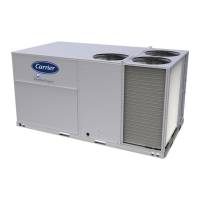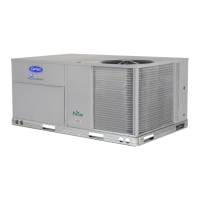23
Curb should be level. This is necessary for unit drain to function
properly. Unit leveling tolerances are shown in Fig. 20. Refer to
Accessory Roof Curb Installation Instructions for additional infor-
mation as required.
Install insulation, cant strips, roofing felt, and counter flashing as
shown. Ductwork must be attached to curb and not to the unit.
Thru-the-base power connection must be installed before the unit
is set on the roof curb. If field-installed thru-the-roof curb gas con-
nections are desired, remove knockout in basepan located in the
gas section; see Fig. 21 for location. Gas connections and power
connections to the unit must be field-installed after the unit is in-
stalled on the roof curb.
If electric and control wiring is to be routed through the basepan,
remove knockouts in basepan located in control box area of access
panel; see Fig. 2-16 for basepan knockout locations. Attach the
service connections to the basepan.
Fig. 20 — Unit Leveling Tolerances
Fig. 21 — Typical Access Panel and Compressor
Locations
SLAB MOUNT (HORIZONTAL UNITS ONLY)
Provide a level concrete slab that extends a minimum of 6-in.
(150 mm) beyond unit cabinet. Install a gravel apron in front of
condenser coil air inlet to prevent grass and foliage from obstruct-
ing airflow.
NOTE: Horizontal units may be installed on a roof curb if
required.
ALTERNATE UNIT SUPPORT (IN LIEU OF CURB OR
SLAB MOUNT)
A non-combustible sleeper rail can be used in the unit curb sup-
port area. If sleeper rails cannot be used, support the long sides of
the unit with a minimum of 4 equally spaced 4-in. x 4-in. (102 mm
x 102 mm) pads on each side. Locate pads so that they support the
rails. Make sure to avoid the fork openings.
Step 5 — Field Fabricate Ductwork
Cabinet return-air static pressure (a negative condition) shall not
exceed 0.5 in. wg (87 Pa) with economizer or without economizer.
For vertical ducted applications, secure all ducts to roof curb and
building structure. Do not connect ductwork to unit.
Fabricate supply ductwork so that the cross sectional dimensions
are equal to or greater than the unit supply duct opening dimen-
sions for the first 18-in. (458 mm) of duct length from the unit
basepan.
Insulate and weatherproof all external ductwork, joints, and roof
openings with counter flashing and mastic in accordance with ap-
plicable codes.
Ducts passing through unconditioned spaces must be insulated
and covered with a vapor barrier.
If a plenum return is used on a vertical unit, the return should be
ducted through the roof deck to comply with applicable fire codes.
A minimum clearance is not required around ductwork.
Step 6 — Rig and Place Unit
Keep unit upright and do not drop. Spreader bars are not re-
quired if top crating is left on unit. Rollers may be used to move
unit across a roof. Level by using unit frame as a reference. See
Table 2 (on page 2) and Fig. 22 for additional information.
Lifting holes are provided in base rails as shown in Fig. 22. Refer
to rigging instructions on unit.
Before setting the unit onto the curb, recheck gasketing on curb.
A-B
0.25 (6)
B-C
0.5 (12)
A-C
0.5 (12)
MAXIMUM ALLOWABLE
DIFFERENCE IN. (MM)
A
B
C
CONTROL BOX
ACCESS PANEL
FILTER AND
INDOOR COIL
ACCESS PANEL
INDOOR BLOWER
ACCESS PANEL
GAS HEAT
ACCESS PANEL
COMPRESSOR
(EACH SIDE)
HOOD CARTON LOCATION
(REAR ACCESS PANEL)
CAUTION
PROPERTY DAMAGE HAZARD
Failure to follow this caution may result in damage to roofing
materials.
Membrane roofs can be cut by sharp sheet metal edges. Be
careful when placing any sheet metal parts on such roof.
CAUTION
UNIT DAMAGE HAZARD
Failure to follow this caution may result in equipment damage.
All panels must be in place when rigging. Unit is not designed
for handling by fork truck when packaging is removed.
If using top crate as spreader bar, once unit is set, carefully
lower wooden crate off building roof top to ground. Ensure
that no people or obstructions are below prior to lowering the
crate.

